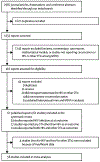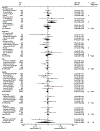Circumcision to prevent HIV and other sexually transmitted infections in men who have sex with men: a systematic review and meta-analysis of global data
- PMID: 30879508
- PMCID: PMC7779827
- DOI: 10.1016/S2214-109X(18)30567-9
Circumcision to prevent HIV and other sexually transmitted infections in men who have sex with men: a systematic review and meta-analysis of global data
Abstract
Background: Men who have sex with men (MSM) are disproportionately affected by HIV and other sexually transmitted infections (STIs) worldwide. Previous reviews investigating the role of circumcision in preventing HIV and other STIs among MSM were inconclusive. Many new studies have emerged in the past decade. To inform global prevention strategies for HIV and other STIs among MSM, we reviewed all available evidence on the associations between circumcision and HIV and other STIs among MSM.
Methods: In this systematic review and meta-analysis, we searched PubMed, Web of Science, BioMed Central, Scopus, ResearchGate, Cochrane Library, Embase, PsycINFO, Google Scholar, and websites of international HIV and STI conferences for studies published before March 8, 2018. Interventional or observational studies containing original quantitative data describing associations between circumcision and incident or prevalent infection of HIV and other STIs among MSM were included. Studies were excluded if MSM could not be distinguished from men who have sex with women only. We calculated pooled odds ratios (ORs) and their 95% CIs using random-effect models. We assessed risk of bias using the Newcastle-Ottawa scale.
Findings: We identified 62 observational studies including 119 248 MSM. Circumcision was associated with 23% reduced odds of HIV infection among MSM overall (OR 0·77, 95% CI 0·67-0·89; number of estimates [k]=45; heterogeneity I2=77%). Circumcision was protective against HIV infection among MSM in countries of low and middle income (0·58, 0·41-0·83; k=23; I2=77%) but not among MSM in high-income countries (0·99, 0·90-1·09; k=20; I2=40%). Circumcision was associated with reduced odds of herpes simplex virus (HSV) infection among MSM overall (0·84, 0·75-0·95; k=5; I2=0%) and penile human papillomavirus (HPV) infection among HIV-infected MSM (0·71, 0·51-0·99; k=3; I2=0%).
Interpretation: We found evidence that circumcision is likely to protect MSM from HIV infection, particularly in countries of low and middle income. Circumcision might also protect MSM from HSV and penile HPV infection. MSM should be included in campaigns promoting circumcision among men in countries of low and middle income. In view of the substantial proportion of MSM in countries of low and middle income who also have sex with women, well designed longitudinal studies differentiating MSM only and bisexual men are needed to clarify the effect of circumcision on male-to-male transmission of HIV and other STIs.
Funding: National Natural Science Foundation of China, National Science and Technology Major Project of China, Australian National Health and Medical Research Council Early Career Fellowship, Sanming Project of Medicine in Shenzhen, National Institutes of Health, Mega Projects of National Science Research for the 13th Five-Year Plan, Doris Duke Charitable Foundation.
Copyright © 2019 The Author(s). Published by Elsevier Ltd. This is an Open Access article under the CC BY 4.0 license. Published by Elsevier Ltd.. All rights reserved.
Conflict of interest statement
Conflict of Interest Disclosures
We declare no competing interests.
Figures





Comment in
-
Benefits of male circumcision for MSM: evidence for action.Lancet Glob Health. 2019 Apr;7(4):e388-e389. doi: 10.1016/S2214-109X(19)30038-5. Lancet Glob Health. 2019. PMID: 30879496 No abstract available.
-
Is circumcision an answer for HIV prevention in men who have sex with men?Lancet Glob Health. 2019 Aug;7(8):e1011. doi: 10.1016/S2214-109X(19)30274-8. Lancet Glob Health. 2019. PMID: 31303287 No abstract available.
-
Is circumcision an answer for HIV prevention in men who have sex with men? - Authors' reply.Lancet Glob Health. 2019 Aug;7(8):e1012. doi: 10.1016/S2214-109X(19)30270-0. Lancet Glob Health. 2019. PMID: 31303288 No abstract available.
-
Trauma, and Genital and Urethral Reconstruction.J Urol. 2022 May;207(5):1144-1147. doi: 10.1097/JU.0000000000002464. Epub 2022 Feb 10. J Urol. 2022. PMID: 35139647 No abstract available.
References
-
- Unemo M, Bradshaw CS, Hocking JS, et al. Sexually transmitted infections: challenges ahead. Lancet Infect Dis 2017; 17: e235–e79. - PubMed
-
- Bailey RC, Moses S, Parker CB, et al. Male circumcision for HIV prevention in young men in Kisumu, Kenya: a randomised controlled trial. Lancet 2007; 369: 643–56. - PubMed
Publication types
MeSH terms
Grants and funding
LinkOut - more resources
Full Text Sources
Medical
Miscellaneous

